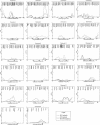Genomewide linkage analysis of quantitative spirometric phenotypes in severe early-onset chronic obstructive pulmonary disease
- PMID: 11914989
- PMCID: PMC447597
- DOI: 10.1086/340316
Genomewide linkage analysis of quantitative spirometric phenotypes in severe early-onset chronic obstructive pulmonary disease
Abstract
Chronic obstructive pulmonary disease (COPD) is a common, complex disease associated with substantial morbidity and mortality. COPD is defined by irreversible airflow obstruction; airflow obstruction is typically determined by reductions in quantitative spirometric indices, including forced expiratory volume at 1 s (FEV(1)) and the ratio of FEV(1) to forced vital capacity (FVC). To identify genetic determinants of quantitative spirometric phenotypes, an autosomal 10-cM genomewide scan of short tandem repeat (STR) polymorphic markers was performed in 72 pedigrees (585 individuals) ascertained through probands with severe early-onset COPD. Multipoint variance-component linkage analysis (using SOLAR) was performed for quantitative phenotypes, including FEV(1), FVC, and FEV(1)/FVC. In the initial genomewide scan, significant evidence for linkage to FEV(1)/FVC was demonstrated on chromosome 2q (LOD score 4.12 at 222 cM). Suggestive evidence was found for linkage to FEV(1)/FVC on chromosomes 1 (LOD score 1.92 at 120 cM) and 17 (LOD score 2.03 at 67 cM) and to FVC on chromosome 1 (LOD score 2.05 at 13 cM). The highest LOD score for FEV(1) in the initial genomewide scan was 1.53, on chromosome 12, at 36 cM. After inclusion of 12 additional STR markers on chromosome 12p, which had been previously genotyped in this population, suggestive evidence for linkage of FEV(1) (LOD score 2.43 at 37 cM) to this region was demonstrated. These observations provide both significant evidence for an early-onset COPD-susceptibility locus on chromosome 2 and suggestive evidence for linkage of spirometry-related phenotypes to several other genomic regions. The significant linkage of FEV(1)/FVC to chromosome 2q could reflect one or more genes influencing the development of airflow obstruction or dysanapsis.
Figures


References
Electronic-Database Information
-
- Celera Discovery System, http://cds.celera.com/cds/login.cfm
-
- Center for Medical Genetics, Marshfield Medical Research Foundation, http://research.marshfieldclinic.org/genetics/
-
- UCSC Human Genome Project Working Draft (“Golden Path”), http://genome.cse.ucsc.edu/
References
-
- American Thoracic Society (1995) Standardization of spirometry: 1994 update. Am J Respir Crit Care Med 152:1107–1136 - PubMed
-
- Beaty TH, Liang KY, Seerey S, Cohen BH (1987) Robust inference for variance components models in families ascertained through probands. II. Analysis of spirometric measures. Genet Epidemiol 4:211–221 - PubMed
-
- Blumenthal MN, Rich SS, King R, Weber J (1998) Approaches and issues in defining asthma and associated phenotypes map to chromosome susceptibility areas in large Minnesota families: The Collaborative Study for the Genetics of Asthma (CSGA). Clin Exp Allergy 28 Suppl 1:51–55; discussion 65–66 - PubMed
Publication types
MeSH terms
Grants and funding
LinkOut - more resources
Full Text Sources
Medical

